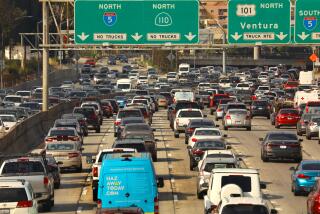Retail landlords see signs of hope
Market conditions are improving slightly for retail landlords, a new report says -- or, more accurately, conditions are worsening at a slower pace.
Vacancies at neighborhood shopping centers, which are usually anchored by a grocery store, grew in the fourth quarter of 2009 at the slowest pace since the end of 2007, according to an analysis released Wednesday by CBRE Econometric Advisors. About 12.4% of the space in such centers was empty at the end of last year.
The report predicted that the vacancy rate will peak at 12.8% in the third quarter of this year.
“After the dismal conditions of the retail real estate market during the past two years, there are signs of stabilization,” economist Abigail Marks of CBRE said.
Although 2009 was one of the worst years on record for occupied space with a loss of more than 19 million square feet nationwide, the negative trend has been easing since peaking in the first quarter of last year. This year will also see a net loss of rented space, but conditions will turn positive in 2011 as landlords see more space rented than vacated.
Southern California may lag behind other parts of the country in the recovery, though, said George Whalin, president of Retail Management Consultants in Carlsbad, Calif.
“I think the third quarter is a little too optimistic,” Whalin said. “We need to solve the unemployment problem before we can solve the retail problem. It will be the first quarter of next year before we see a rebound here.”
The CBRE study also included community shopping centers, which are slightly larger than neighborhood centers and may be anchored by a small department store or discount store.
With many national retailers closing unproductive stores or going out of business since the recession began, landlords have often struggled to keep the lights on. It many cases they have cut rents or provided other financial breaks to help their tenants stay in business.
Stronger retailers are now trying to grab market share, taking advantage of space availability in preferred locations at reduced rents, said Bernard J. Haddigan, a managing director of real estate brokerage Marcus & Millichap.
“This is the seed of the next retail growth cycle, which will undoubtedly take shape over the next two to three years,” he said.
When the retail industry fell into distress in 2008, shopping center developers slammed on the brakes. Shopping center space grew by only 0.7% in 2009, compared with a 30-year historical annual average of 3.1%, economist Marks said, and should fall to a mere 0.2% for this year.
“Oversupply will not be a concern for the next several years,” Marks said.
Neighborhood shopping centers built to serve new housing developments have taken a beating in regions where the single-family housing market collapsed, Haddigan said.
“The economic shock following the collapse of Lehman Bros. led to soaring store closures, tenant bankruptcies and lease renegotiations,” he said. “Although the worst of the crisis has passed, retail property fundamentals will soften further this year before bottoming out.”
Consumer attitudes will be key, Marks said.
“People ask themselves, do I pay more for organic foods? Do I go to the drugstore today?” she said. “It’s all about the consumer’s psyche.”







